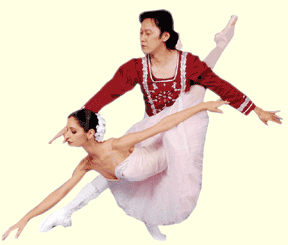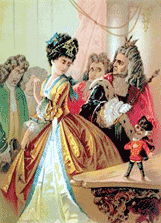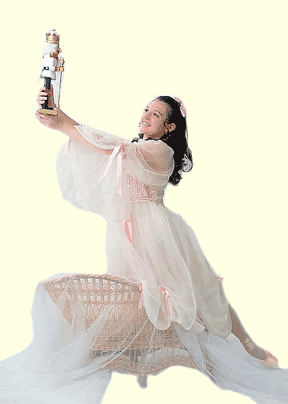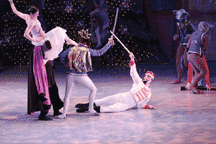|
|||||
|
Why a 200-year-old fantasy is Christmas’s favorite balletby Carrie MadrenBay Weekly Senior Staff WriterIs it the stately music, the military precision of brass yielding to chiffon violin lines that flow like ribbon? The story of a dream come true? The nostalgia of a romanticized Victorian Christmas Eve? The silent spectacle of graceful dancers in colorful costumes? Music, nostalgia, story or dance, The Nutcracker reels us into its magic each year. During the holidays, ballet takes the limelight, using the wordless language of dance to tell a two-century-old story. In cities throughout the United States, The Nutcracker is holiday tradition at its invariable best. The Nutcracker has all the elements of an exciting story: tension, romance, dancing, fighting, fantasy, mystery and adventure. We’re now in the midst of Nutcracker season. Maryland Ballet Theatre’s Thanksgiving performances charmed audiences still full from turkey dinners. This weekend begins Ballet Theatre of Maryland’s fantastical journey. Companies great and small perform each week until Christmas. Tradition, artistry, excitement and the pull of money combine each December to open Nutcracker’s mysterious portal into another Christmas world. Making TraditionYear after year, audiences return for their annual dose of holiday magic. The ballet has “settled into a ritual-like status,” in the U.S., says Jennifer Fisher, Nutcracker scholar at the University of California, Irvine. Nutcracker lures kids to a fantasy play world where toys come alive and dreams become real. For adults, it’s a peaceful stopover amidst the busyness of the season. For all, it’s an escape into another realm. “It’s a child’s dream of paradise; for adults, it’s like a little Utopia,” says Fisher, author of Nutcracker Nation: How an Old World Ballet Became a Christmas Tradition in the New World. It’s not only popular for patrons, who make it a tradition to commune with sugar plum fairies year after year. It’s popular with hundreds of dance companies and dancing schools that spend countless hours rehearsing and thousands of dollars producing. “I was the Sugar Plum Fairy, and I get to revisit a place from my childhood,” says Arleene Monahan, who directs the 34 young dancers of Maryland Ballet Theatre. Dancers feel the same way. “It’s definitely become a tradition for me. I’ve been dancing in Nutcrackers since I was 10,” says Jessica Fry, 29, who’s worked her way up to dancing the Snow Queen role in Ballet Theatre of Maryland’s 2006 performance. Making a Christmas StarAs the country’s only nutcrackerologist, Fisher has figured out the whys and wherefores of her subject’s appeal. “Nutcracker was a ballet accidentally set at Christmas time,” she says. “It has a Christmas theme, but it’s not religious [which is appealing] in a country of immigrants.” North America’s cultural obsession with the winter holiday helped secure Nutcracker’s place in our hearts and calendars. Eager to kindle the spirit of Christmas, people are willing to spend money to see a show. All the better if it’s one that helps them romanticize the past, looking back on the year and beyond, particularly to the Victorian era. That same urge makes Charles Dickens’ A Christmas Carol so compelling. Russia, where the Nutcracker was launched onto stage by Peter Tchaikovsky’s suite, lacks such strong ties to Christmas, says Vladimir Lande, who conducted Southern Maryland’s COSMIC Symphony in its Nutcracker suite danced by the Ukrainian Ballet. “In Moscow, it’s performed year-round.” Clara’s dream was a fantasy too farfetched for Russia, says Fisher. “It was about a little girl and her dreams, and that theme wasn’t resonant for Russians, but it was for America.” It wasn’t only dreams, but also dance lessons, that drew Americans to Nutcracker. “A lot of children needed to learn ballet,” Fisher says. “What better ballet to showcase children and their dreams.” “The magic was created in this country,” says Dianna Cuatto, director at Ballet Theatre of Maryland. She danced in Nutcrackers from 1960 through 1999, as well as choreographing and directing shows. Here in North America, many ballet theaters see more seats filled come Christmas than other times of the year. “People may not know ballet, but they know the Nutcracker,” says Monahan, director of the Maryland Ballet Theatre. “You don’t have to know ballet to have appreciation for Nutcracker.” The familiar warmth and melodies of Nutcracker make it a ballet accessible for patrons who might not see Swan Lake. Nutcracker claims its family appeal in being accessible for every age starting with toddlers drawn to the rhythm, says conductor Lande. “Music is the language that goes directly to the emotional part of the brain, so it can deliver information to the heart. Because the language is so abstract, anyone can relate to it,” says Lande. Thus it’s sophisticated enough to appeal to the children’s parents and grandparents. Nutcracker wins holiday hearts with its multi-faceted appeal. “It was a great combination of circumstances that gave it power,” says Fisher. For starters, “it makes a lot of money.” Dancing Dollar Signs“I think the reason that most companies do it is because it’s the biggest revenue of the year and helps to sustain a company thru the season,” says Pamela Moore, who directs the National Ballet, Maryland’s oldest professional ballet company and Prince George’s Community College’s resident ballet company. Because not everyone celebrates Christmas, the National Ballet diversifies with two Nutcrackers, one a full-length Nutcracker and the other a tribute to Duke Ellington called Nutcracker Sweet. National Ballet’s Nutcracker costs over $50,000 to produce, but Moore expects to bring in $11,000 profit, after all the expenses are paid. For many schools, however, Nutcracker does not butter the bread. “I cross my fingers every year that it pays for itself,” says Maryland Ballet Theatre’s Monahan. For that reason, Monahan says she puts on “one of the more modest Nutcrackers in the area, but at our humble little theater at Old Mill we do extremely well.” The first year Cuatto directed at Ballet Theatre of Maryland, her budget rose to $124,000. That paid for the dancers’ salaries, costumes, set design, programs and more.
The company’s return on $124,000 ranges from $86,000 to $114,000. “The largest cut of the money goes to dancers,” says Cuatto, who says that the Sugar Plum Fairy can wear out a pair of pointe shoes in just one performance. Cuatto considers her ballet cheap compared to other professional ballets. “Richmond Ballet did one as I left there that cost $2.5 million,” she says. “That’s a small company, so you can only imagine what New York City Ballet spends.” To save money, Nutcracker directors get creative. One of Maryland Ballet Theatre’s special effects tricks is to use a mirror ball for the snow scene. “As the lights hit it, you’ve got the effect of snow,” says Monahan. The Olney Ballet Theatre plans to borrow costumes from the Washington Ballet. Severna Park School of Dance’s director Barbara Haskell, whose production costs $30,000, relies on the Nutcracker to teach her students rather than make a profit. “With the costuming, paying teachers, building sets,” says Haskell, who began her studio last year, “we don’t really expect to make money.” Nutcracker costs so much, in part, because dance directors aspire to produce it in the fullest. Last year, Abigail Francisco’s dream came true when big donations came in to bring the Annapolis Symphony Orchestra to Calvert County to play live for her 14th annual Nutcracker. That was her last Nutcracker. Live music added magic to the great score. But raising funds for her first live Nutcracker orchestra wore her out. Francisco says she’ll miss the production, but for those 14 years, from the end of August to the first of December, rehearsals and stage preparations left little time for her husband and son. A 200-Year EvolutionThe story of the Nutcracker was written in 1816 by German author E.T.A. Hoffmann, who named his tale The Nutcracker and the Mouse King. Today’s Nutcracker “doesn’t resemble that story much any more,” says nutcrackerologist Fisher. “There are a lot of elements that weren’t suitable for ballet. People get cursed because a piece of fat hits them — it just didn’t work on a ballet stage.” But Hoffmann’s concept still holds fast. “A little girl has this Wizard of Oz-like journey,” Fisher says. The adaptation we know is, she says, simpler but more appealing to today’s audiences. Danced as a ballet, Nutcracker premiered in 1892 in Russia, choreographed by Marius Petipa to the famous musical score of Peter Tchaikovsky. “Tchaikovsky was amazing at putting music and dance together,” says conductor Lande. “Originally, when it was performed in Russia, there were no children in the production,” Cuatto says. The first person to direct a full-length Nutcracker in the United States was Cuatto’s mentor, William Christensen in 1944 at the San Francisco Ballet, Cuatto says. Christensen’s idea, says Cuatto, who performed with a later production by Christensen in Utah, was “to put the wonder of the child in the Nutcracker. He had no idea that it would grow into this huge phenomenon.” In 1954, George Balanchine, a native Russian, began producing The Nutcracker with the New York City Ballet every year. “In 1957, it aired on CBS on Christmas Day. I don’t think a lot of people knew about it before then,” Fisher says. “People saw the New York City Ballet making a lot of money off it, and when ballet dancers retired in different parts of the nation, they began starting their own local productions.” Mid-century popular culture made The Nutcracker fantasy even more popular. When the film Fantasia came out in the 1940s, says Fisher, “Baby Boomers loved it.” That fantastical world was very similar to the Nutcracker dreamland. “The second act is like a mini-Disneyland,” she says. Making The Nutcracker Their OwnThe easily adaptable Nutcracker is “so flexible that everyone could do their own version of it,” Fisher says. “Some people do the Harlem Nutcracker; there’s also the Hawaiian Nutcracker and the tap-dancing Nutcracker. People in some communities make the Nutcracker look like them.” The National Ballet’s version stays the course, sticking close to the traditional mid-19th century ballet. “We really don’t have the right to take an idea that has been successful and turn it into your hometown,” says director Moore. People go out for a night to get away from where they are, says Moore; that’s why she tries to transport them to another time.
Ballet Theatre of Maryland’s Nutcrackers started with Hoffmann’s story. “I tried to draw in some of those elements a little more without taking it entirely to the dark side,” Cuatto says. “I really tie it into the dream.” In Cuatto’s version, Clara transforms into the sugar plum fairy. Viewers are left wondering if Clara’s journey really was a dream, Cuatto says. Future Nutcrackers by Ballet Theatre of Maryland may venture into uncharted Nutcracker territory. She’d like to do “a version where the rats win. And we may have one or two performance days where the audience can vote on which ending they want,” says Cuatto. “I’m thinking of starting out with a rat scene; then you’ll see the Clara story.” Farther north, in Maryland Ballet Theatre’s performance — it played its 15th this year — dolls stitch the story together. “Who doesn’t dream of being able to play with their dolls?” asks Monahan, who reports she’s the only director she’s ever heard of who doesn’t hold a dress rehearsal before curtains open. “Dresselmeyer brings those dolls to life — the Arabian, Mother Ginger, Truffle, Waltz of the Flowers, the Dew Drop. At the party scene, Clara discovers her dolls.” Out west, the Olney Ballet Theater will produce its first Mary Day version of the Nutcracker. Director Patricia Berrend wanted to do a tribute to the Washington Ballet director, who died July 11. It’s a traditional Nutcracker that Berrend hopes to emulate. Olney Ballet Theatre performed its version of the Nutcracker out of the county for years; now Berrend’s bringing the company’s Christmas offering home and sparking a new tradition. An Army of NutcrackersBallet companies great and small must jump hurdles — location, size, budget and proximity to other Nutcrackers — to make theirs a success. “When you don’t perform in the city, you don’t have the large audiences,” says Moore, whose dual productions in Prince George’s County bring in enough audience to fill seven days. With nearly 12 Nutcrackers in Maryland, and a handful more in Washington, D.C., dance companies and schools must share a limited audience base, people who may only pay to see one performance a year. Some studios feel the pinch of competition, but most don’t mind being one in a dozen. “We’re in the business of impacting lives, and I would hope that there’s room for all of us,” says Cuatto, who encourages her students to follow her example and see more than one Nutcracker. Directors stagger their shows, each choosing a weekend for themselves. Maryland Ballet Theater sets their performances apart with an earlier opening and lower pricing, $13 a ticket. “No two productions are the same,” says Monahan. “This is a big world. There’s more than one computer company, more than one soda company. Why not another Nutcracker?” Competition for dancers also makes studios look around, says Monahan. “There’s only so many male dancers in the area. They realize what a commodity they are,” she says. In her Nutcracker, the Mouse King was a Mouse Queen this year. Most Nutcrackers are danced to recorded music. When symphonies accompany a company, musicians must struggle with their own challenges. “It’s one of those difficult scores,” says conductor Lande. “It goes about two hours. It’s very challenging for every instrument, with dramatic things happening.” Lande has conducted Nutcracker countless times, and “every time I conduct it, I find something new,” he says. “This is like a great book I want to read again.” A Christmas Gift of DanceNutcracker is as rewarding as it is demanding. “What my students have is a gift,” says Maryland Ballet Theatre’s Monahan. “My mission is to perfect that talent,” she says. Her second mission is for students to share their gift with others, including Casey Cares families of children with illnesses, whom Monahan comps on her dream voyage. For Ballet Theatre of Maryland’s Cuatto, the gift keeps giving. “I believe that the beauty that we create on stage,” she says, “in some way offsets the negative things that happen on our planet.” For all those reasons and more, Nutcracker is an annual journey of which we never tire.
|
|||||
|
|
|||||
|
© COPYRIGHT 2004 by New Bay Enterprises, Inc. All rights reserved.
|



 Cracking the Nutcracker Code
Cracking the Nutcracker Code


